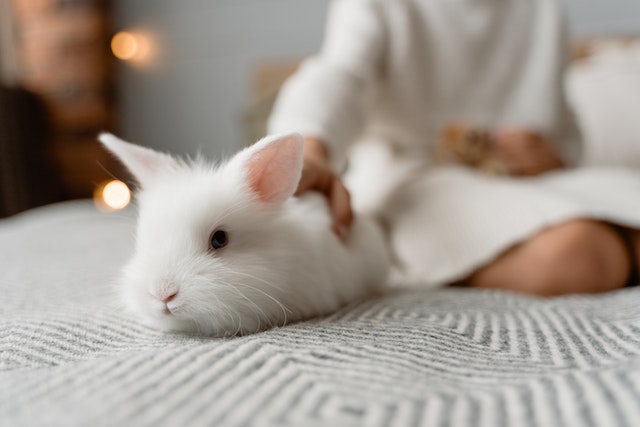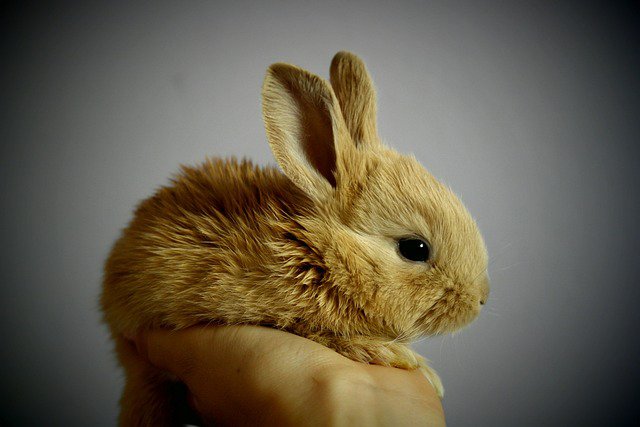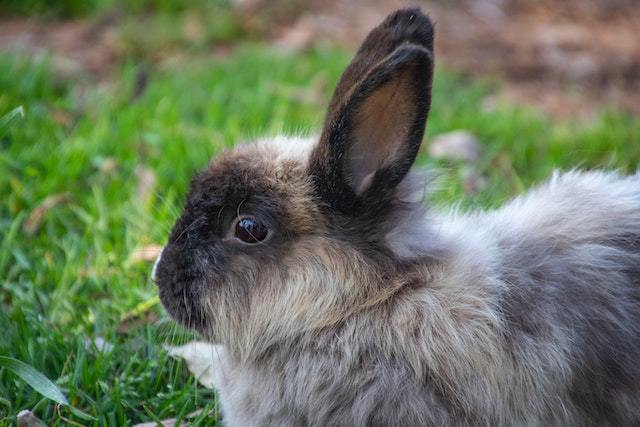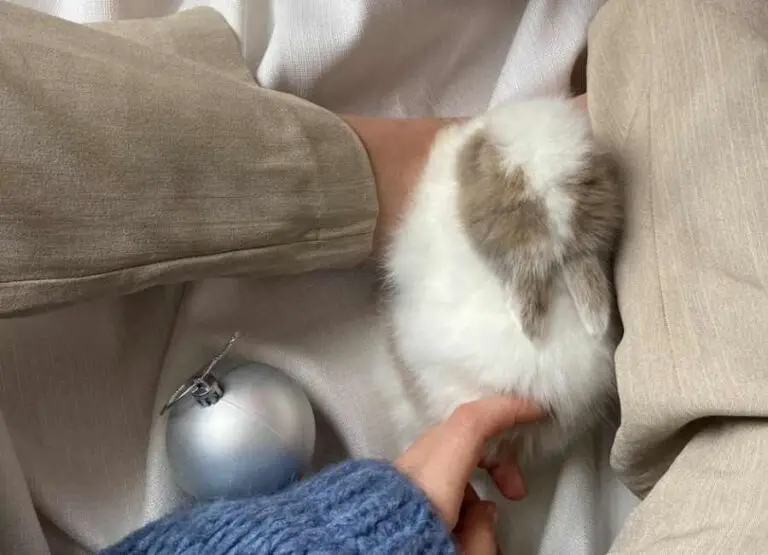How to Comfort a Dying Rabbit [12 Helpful Strategies]
![How to Comfort a Dying Rabbit [12 Helpful Strategies] How to Comfort a Dying Rabbit](https://petcreeks.com/wp-content/uploads/2023/10/How-to-Comfort-a-Dying-Rabbit.jpg)
Let’s discuss how to comfort a dying rabbit…
Today, we’re diving into a delicate topic – how to comfort a dying rabbit.
It’s never easy to see our furry friends in pain, but with a few simple tips, we can provide them with the love and support they need in their final moments.
So, let’s get started…
How to Comfort a Dying Rabbit
The following are some tips on how to comfort a dying rabbit:
1. Create a Calm and Comfortable Environment for Your Dying Rabbit
When a rabbit is nearing the end of its life, it’s important to create a calm and comfortable environment to help ease its discomfort. Here are some steps you can take:
a. Provide a quiet space: Find a quiet area in your home where your rabbit can rest undisturbed. Limit loud noises and sudden movements that may startle or stress the rabbit.
b. Create a safe enclosure: Set up a comfortable enclosure for your rabbit, ensuring it has enough space to move around but is not too large to navigate easily. Provide hiding spots, such as a small box or tunnel, where the rabbit can retreat if it feels the need.
c. Offer familiar bedding: Use soft bedding materials, such as hay or shredded paper, to line the enclosure. This will provide a cozy and familiar environment for your rabbit.
d. Maintain a clean environment: Regularly clean the enclosure to ensure it remains hygienic. Remove any soiled bedding and replace it with fresh bedding to keep your rabbit comfortable and prevent any potential infections.
2. Maintain Proper Temperature Around Your Dying Rabbit
Rabbits are sensitive to temperature changes, so it’s important to maintain a suitable temperature for your dying rabbit. Here’s what you can do:
a. Keep the environment warm: Rabbits prefer temperatures between 60-70°F (15-21°C). Ensure the room where your rabbit is located is kept at a comfortable temperature. Avoid exposing the rabbit to drafts or extreme heat/cold.
b. Use heating pads or blankets: If necessary, you can provide additional warmth by using heating pads or blankets. Place them under a portion of the enclosure, ensuring the rabbit has the option to move away from the heat source if it becomes too warm.
c. Monitor temperature changes: Regularly check the temperature in the room and adjust as needed. Use a thermometer to accurately measure the temperature and ensure it remains within the optimal range for your rabbit’s comfort.
3. Provide Soft Bedding for Your Dying Rabbit
Comfortable bedding is essential for a dying rabbit. Here are some tips for choosing and providing suitable bedding:
a. Choose soft and absorbent materials: Opt for bedding materials that are soft, such as hay or shredded paper. These materials provide cushioning and absorb moisture, keeping your rabbit dry and comfortable.
b. Avoid dusty or irritating bedding: Some bedding materials, such as cedar or pine shavings, can be irritating to a rabbit’s respiratory system. Avoid using these types of bedding and opt for safer alternatives.
c. Replace soiled bedding regularly: Check the bedding daily and remove any soiled or wet areas. Replace it with fresh bedding to maintain a clean and comfortable environment for your rabbit.
4. Maintain Proper Hygiene Around Your Dying Rabbit
When comforting a dying rabbit, it is important to maintain proper hygiene to ensure their comfort and well-being. Here are some tips to follow:
a. Keep the living area clean: Regularly clean the rabbit’s living area, including their cage or enclosure, to maintain a clean and comfortable environment. Remove any soiled bedding or litter and replace it with fresh, clean material.
b. Provide soft and comfortable bedding: Use a soft and comfortable bedding material, such as hay or straw, to provide a cozy resting place for the rabbit. Ensure that the bedding is changed regularly to maintain cleanliness.
c. Groom the rabbit: Gently groom the rabbit to keep their fur clean and free from mats or tangles. Use a soft brush or comb to remove any loose fur and keep their coat in good condition.
d. Monitor for signs of illness: Keep a close eye on the rabbit’s health and monitor for any signs of illness or discomfort. If you notice any changes in their behavior, appetite, or appearance, consult a veterinarian for guidance.
5. Offer Favorite Nutritious Foods
During the final stages of a rabbit’s life, it is important to offer them their favorite nutritious foods to ensure their comfort and provide them with the necessary nutrients. Here are some tips to consider:
a. Consult a veterinarian: Before making any changes to the rabbit’s diet, consult a veterinarian who can provide guidance based on the rabbit’s specific needs and health condition.
b. Offer a variety of foods: Provide a variety of fresh vegetables, such as leafy greens, carrots, and herbs, that the rabbit enjoys. This can help stimulate their appetite and provide them with essential nutrients.
c. Provide unlimited hay: Hay is an essential part of a rabbit’s diet and should be available at all times. It helps maintain their dental health and provides necessary fiber.
d. Avoid foods that may cause digestive issues: Some foods, such as high-sugar or high-fat treats, can cause digestive issues in rabbits. Avoid offering these foods to prevent any discomfort or complications.
6. Provide Pain Management
It is important to ensure that a dying rabbit is as comfortable as possible during their final days. Here are some ways to provide pain management:
a. Consult a veterinarian: A veterinarian can assess the rabbit’s condition and prescribe appropriate pain management medications if necessary. They can also provide guidance on the proper dosage and administration.
b. Create a quiet and peaceful environment: Minimize loud noises and disturbances in the rabbit’s environment to create a calm and peaceful atmosphere. This can help reduce stress and promote comfort.
c. Provide a comfortable resting area: Ensure that the rabbit has a comfortable and cozy resting area where they can relax. Use soft bedding and provide a warm environment if needed.
d. Offer gentle and soothing interactions: Spend time with the rabbit, offering gentle interactions such as petting or talking softly. This can provide comfort and reassurance during their final days.
7. Spend Time With Your Dying Rabbit
When a rabbit is nearing the end of its life, it’s important to provide comfort and companionship. Spending time with your dying rabbit can help alleviate any feelings of loneliness or fear it may be experiencing. Here are some ways you can comfort your dying rabbit:
- Create a quiet and peaceful environment: Find a calm and quiet space where your rabbit can rest comfortably. Ensure that the area is free from loud noises and disturbances.
- Provide a comfortable and familiar space: Set up a cozy area with soft bedding and familiar items, such as your rabbit’s favorite toys or blankets. This can help create a sense of security for your rabbit.
- Offer gentle physical contact: If your rabbit is comfortable with being touched, you can gently stroke its fur or hold it close. This physical contact can provide reassurance and comfort to your rabbit.
- Monitor your rabbit’s needs: Pay attention to your rabbit’s behavior and needs. Offer food and water if your rabbit is still able to eat and drink. Make sure the temperature is appropriate and adjust it if necessary.
8. Speak to Your Dying Rabbit in a Comforting Tone
Rabbits are sensitive animals and can pick up on the emotions and tone of your voice. Speaking to your dying rabbit in a comforting and soothing tone can help create a sense of calm and security. Here are some tips for speaking to your dying rabbit:
- Use a soft and gentle voice: Speak in a soft and gentle tone to convey a sense of comfort and reassurance. Avoid using loud or harsh tones, as this can cause stress or anxiety for your rabbit.
- Choose comforting words: Use comforting words and phrases to communicate with your rabbit. You can say things like “It’s okay, you’re safe” or “I love you, you’re not alone.” Your rabbit may not understand the words, but the tone and intention behind them can provide comfort.
- Spend time talking to your rabbit: Sit with your rabbit and engage in gentle conversation. Talk about happy memories or simply offer words of love and support. Your presence and soothing voice can make a difference to your rabbit.
9. Keep Your Dying Rabbit Away From Other Pets
If you have other pets in your home, it’s important to keep your dying rabbit separate from them. This is to ensure the comfort and safety of your rabbit during its final moments. Here’s why it’s important to keep your dying rabbit away from other pets:
- Prevent stress and anxiety: Other pets, such as dogs or cats, may not understand the situation and may exhibit curious or predatory behavior towards the dying rabbit. This can cause additional stress and anxiety for your rabbit during its final moments.
- Avoid potential harm: Some pets may unintentionally harm or injure a dying rabbit, especially if they are not familiar with rabbits or have a prey drive. Keeping your dying rabbit separate can help prevent any accidental harm.
- Provide a peaceful environment: By keeping your dying rabbit away from other pets, you can create a calm and peaceful environment where your rabbit can spend its final moments in comfort.
10. Place Familiar Items Around Your Dying Rabbit
When a rabbit is nearing the end of its life, it can be comforting to provide familiar items in its environment. This can help create a sense of security and reduce stress for the rabbit. Some familiar items you can place around your dying rabbit include:
- Favorite toys: If your rabbit has a favorite toy, place it near them. This can provide a source of comfort and familiarity.
- Bedding: Use the same bedding material that your rabbit is accustomed to. This can help create a familiar scent and texture.
- Food and water bowls: Keep the rabbit’s food and water bowls nearby, ensuring they have easy access to hydration and nutrition.
By surrounding your dying rabbit with familiar items, you can help create a sense of comfort and security during their final moments.
11. Encourage Proper Hydration
Proper hydration is essential for a dying rabbit’s comfort. Dehydration can worsen their condition and lead to additional discomfort. Here are some ways to encourage hydration:
- Provide fresh water: Ensure that your rabbit has access to fresh water at all times. You may need to assist them in drinking by using a syringe or a small dish if they are unable to drink on their own.
- Offer wet food: Wetting your rabbit’s food can help increase their water intake. You can mix water with their pellets or offer them fresh vegetables with high water content, such as cucumber or lettuce.
It’s important to monitor your rabbit’s hydration levels and consult with a veterinarian if you notice signs of severe dehydration.
12. Offer Gently Stroke or Petting if Your Dying Rabbit Seems Receptive
Providing gentle strokes or petting to a dying rabbit can offer comfort and reassurance. However, it’s crucial to observe your rabbit’s behavior and body language to determine if they are receptive to physical contact. Some rabbits may prefer to be left alone during this time, while others may seek comfort through gentle touch.
If your rabbit seems receptive to petting, keep the following tips in mind:
- Be gentle: Use soft and slow strokes to avoid causing any discomfort or stress to your rabbit.
- Observe their response: Pay attention to your rabbit’s body language. If they show signs of discomfort or try to move away, respect their boundaries and give them space.
- Focus on areas they enjoy: Rabbits often enjoy being petted on their head, cheeks, or back. Avoid sensitive areas such as their stomach or hind legs.
Remember that every rabbit is unique, and their preferences for physical contact may vary. Always prioritize your rabbit’s comfort and well-being.
Considering Euthanasia for Your Dying Rabbit
When a rabbit is in the advanced stages of illness or suffering, euthanasia may be a compassionate option to prevent further pain and distress.
It is essential to consult with a veterinarian who can assess your rabbit’s condition and provide guidance on the best course of action.
Euthanasia should be considered when:
- The rabbit is experiencing severe pain or discomfort that cannot be alleviated.
- The rabbit is unable to eat, drink, or move without significant difficulty.
- The rabbit’s quality of life is greatly diminished, and there is no reasonable expectation of improvement.
Discussing euthanasia with a veterinarian can help ensure that your rabbit’s end-of-life care is handled with compassion and respect.
Read more about the common signs your rabbit is dying.
How to Get Over the Death of Your Rabbit
Losing a beloved pet can be a deeply emotional and challenging experience. Coping with the death of a pet rabbit can be particularly difficult, as they often become cherished members of the family.
Here are a few suggestions on how to navigate the grieving process and find ways to heal:
1. Allow yourself to grieve: Give yourself permission to feel the pain and sadness associated with the loss of your pet rabbit. It’s okay to cry and express your emotions. Acknowledge that grief is a natural part of the healing process.
2. Share your feelings: Reach out to friends or family members who can offer a sympathetic ear. Talking about your pet and the memories you shared can be cathartic. If you don’t have someone to talk to, consider joining online forums or support groups where you can connect with others who have gone through similar experiences.
3. Create a memory keepsake: Consider creating a memorial for your pet rabbit. This could be a photo album, a scrapbook, or even a framed picture. Include pictures, stories, and any special memories you shared. This can help you remember and honor your pet’s life.
4. Establish a new routine: Pets often become a part of our daily routines. With the loss of your rabbit, you may find that there is a void in your daily activities. Consider establishing new routines or hobbies to fill that void. Engaging in activities that bring you joy and provide a sense of purpose can help in the healing process.
5. Seek support from professionals: Sometimes, the grief of losing a pet can feel overwhelming and affect our daily lives. If you find it difficult to cope with the loss on your own, consider seeking professional help. There are therapists and counselors who specialize in pet loss and can provide guidance and support during this difficult time.
6. Consider getting a new pet: While it may seem too soon, some people find comfort in adopting or rescuing another pet after the loss of their rabbit. This doesn’t mean you are replacing your beloved pet but rather opening your heart to a new companion. However, make sure you are emotionally ready for the responsibility and commitment of caring for a new pet.
Remember, everyone grieves differently, and there is no right or wrong way to mourn the loss of a pet. Take the time you need to heal and honor the memories you shared with your pet rabbit.
Eventually, with patience and self-care, you will find a way to move forward while keeping your pet’s memory alive in your heart.
Read more about rabbit health concerns.
Frequently Asked Questions
How can I tell if my rabbit is dying?
The signs of a dying rabbit may include a lack of appetite, difficulty breathing, lethargy, and a decline in overall activity. If you notice these symptoms, it’s important to seek veterinary assistance immediately.
What can I do to keep my dying rabbit comfortable?
Ensure your rabbit’s environment is quiet, warm, and peaceful. Provide soft bedding and a cozy space for them to rest. Additionally, offer fresh water and easily digestible food, such as hay or leafy greens, if they are still eating.
Should I try to move my dying rabbit?
It’s best to avoid unnecessary movement, as dying rabbits may be fragile and easily stressed. If you need to transport them, do so gently and with utmost care, keeping the journey as calm and quiet as possible.
How can I offer emotional support to my dying rabbit?
Spend time near your rabbit, speaking in a soothing voice and offering gentle strokes if they enjoy being touched. Simply being present can provide comfort and reassurance during their final moments.
How do I know when it’s time to euthanize my dying rabbit?
This is a difficult decision that should be made in consultation with a veterinarian. They can assess your rabbit’s condition and provide guidance on whether euthanasia is the most compassionate choice to prevent further suffering.
What should I do after my rabbit passes away?
Take the time to grieve and honor your rabbit’s memory. Consider burying them in a peaceful spot in your backyard or arranging for a respectful cremation. Reach out to support groups or friends who understand the loss of a beloved pet.
Read more about identifying a sick rabbit.
Conclusion
In conclusion, comforting a dying rabbit requires compassion and gentle care. Remember to create a calm and quiet environment, offering soft bedding and soothing music.
Lastly, provide comfort through gentle touch and comforting words, letting your rabbit know they are loved until the very end.




![How to Tell If Your Rabbit Doesn’t Like You [11 Signs] How to Tell If Your Rabbit Doesn’t Like You](https://petcreeks.com/wp-content/uploads/2023/10/animal-4137865_640-1.jpg)

![12 Common Signs Your Rabbit Is Dying [Comfort Them] Signs Your Rabbit is Dying](https://petcreeks.com/wp-content/uploads/2023/10/rabbit-905971_640.jpg)